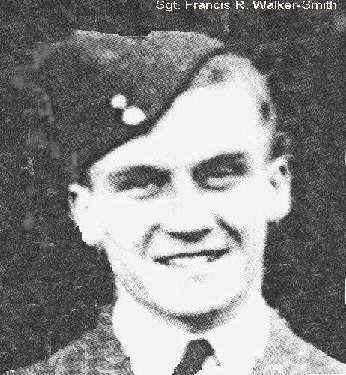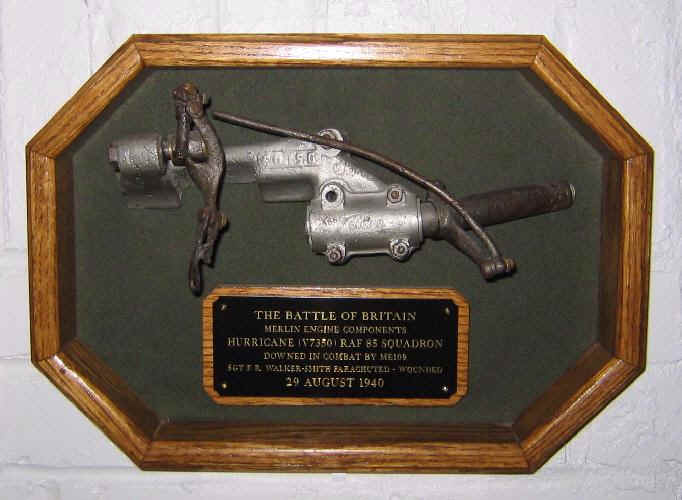
About this Piece of Aluminum -- Aluminum #1 of 2.

CONTACTING RICHARD FRANCIS WALKER-SMITH
England is one of my favorite places; particularly the south coast and South Downs. Just north of the Downs is the little town of Burwash where my wife and I have friends. Rudyard Kipling spent the last 34 years of his life just south of Burwash at the edge of River Dudwell. (There is a point to all this.)
Two miles east of Burwash is the ancient village of Etchingham. River Dudwell trickles in from the north at Etchingham and bends at the village to continue southwest toward Burwash and Rudyard Kipling's estate. (Kipling's "Puck of Pooks Hill" was written about Burwash.)
Etchingham has a small rail station on a line to London. The village was named for a local family who were kin to Elizabeth I. We have rubbed the brasses of Lady Johanna Etchingham (1404) and Sir William Etchingham (1412) and they now reside on two doors at our home. (You have to display them somewhere.)
On the road four miles east of Etchingham is the Kent town of Hawkhurst. I have a small creamer that I bought at a churchyard rummage sale there.
While doing research on English windmills, I went to Mill Field Ley, just south of Wimbish, southwest of Cambridge.
These miscellaneous places with strange names will shortly be connected by this story.
Now let’s turn our attention back to a less peaceful time in this part of England.
At 4:25 p.m., for the fourth time on Sunday, August 18, 1940, Royal Air Force (RAF) fighter pilot Sergeant Francis Richard Walker-Smith took off from Croydon just north of London in his Hawker Hurricane. The Hurricane had number V7350 on the fuselage just under the leading edge of the stabilizer. Also on the fuselage was a white octagonal ring: meaning he was flying in 85 Squadron. This famous squadron was led by Peter Townsend, who was noted for shooting down the first Nazi bomber to fall on Britain.
Townsend would become famous for his military career, but one time he was in the British newspapers was when he was told that the Queen would not approve of him as a proper husband for Princess Margaret, the Queen’s sister. Reason given: Townsend had been previously married. Peter’s and Margaret’s grief could not be hidden from the press. They stopped seeing each other.
But at this time the Battle of Britain was underway between the RAF and the Luftwaffe. The U.S. would not be in the war for another 16 months.
The 85 Squadron was to intercept Me-109s flying at 18,000' near the coastal area of Dungeness on the English Channel. Dungeness is halfway between Dover and Hastings, both Kent sea towns.
Twenty-three-year-old Walker-Smith was born in the small town of Stanley Common in Derbyshire and had joined the RAF as an aircraft fitter June 13, 1937. He became a Sergeant Training Pilot barely six months later, and by April 11, 1940, he was training in Hurricanes.
Walker-Smith had been posted to 85 Squadron May 15, 1940, which was then flying out of France. But later that year, German forces pushed the RAF out of France and back to Britain. (The ground forces knew this event by the general name of "Dunkirk.")
When the Hurricanes of 85 Squadron arrived over Dungeness on the afternoon of August 18th, twelve Me-109s were seen slightly below them and just above scattered clouds -- the Hurricanes were between the sun and the flight of Me-109s. Townsend and Walker-Smith were both involved.
The squadron had instructions to avoid fighters if bombers were present. Townsend did not see any bombers but he could see the Me-109s perfectly.
Townsend decided the opportunity was too good to pass up.
They came down on the German fighters and on the first pass, Townsend, in Hurricane P3854, shot out the cooler of an Me-109 and it started steaming and overheating; then the engine started smoking. The German pilot was taken prisoner that afternoon. Townsend might have saved the man’s life while Townsend was in the process of trying to shoot him down. By becoming a prisoner, the Luftwaffe pilot's war was over. These pilots flew missions until they died, were disabled, or the war was over. Few Luftwaffe pilots who flew in the Battle of Britain, survived the war while on flight status.
The Luftwaffe knew the white octagon emblem carried on all 85 Squadron Hurricane fuselages and I am sure they knew that Townsend's aircraft identification letters were "VY-D"; these letters showing in white on brown camouflage would have stood out.
While concentrating too much on another Me-109, Townsend received hits in the cockpit. He gave full down-elevator, pulling negative g's. The Hurricane’s Rolls-Royce Merlin cut out momentarily while running in the "war boost" throttle position. This rich setting resulted in a lot of black smoke from his engine. The Me-109 broke off the attack, possibly thinking the Hurricane was afire. (The early models of the Merlin engine did not have the fuel-injection that all Me-109s had. The Merlin had a gravity-fed carburetor, so negative g’s would starve the engine, then the auto choke would start flooding the engine.)
On that first pass, Walker-Smith attacked an Me-109 and it exploded on hitting the sea.
It is difficult to compare the performances of aircraft types when they are assigned different combat roles -- but yet the Hurricanes and Spitfires are compared.
During the Battle of Britain, on a typical flight of single-seat aircraft, the Hurricanes might comprise about 25% more than the number of Spitfires. The Hurricanes shot down about the same percentage more German aircraft than did the Spitfires; that is, about 25% more.
While the Spitfires were to concentrate on the German escort fighters, the Hurricanes were shooting down the bomb-carrying German aircraft.
Counting aircraft against aircraft is not a measure of their contribution in the defense of Britain. Regardless, the Hurricane was not as out-classed in the Battle of Britain as many think.
Later in the month, Walker-Smith shot down two twin-engine, Bf-110 fighter-bombers; on the 26th, a twin-engine Do-17 bomber; and on the 28th, another Me-109.
He had mixed luck on Thursday, the 29th.
At 4:00 p.m. 85 Squadron was over the coastal chalk cliffs of Beachy Head, halfway between Hastings and Brighton. Brighton is west of Hastings and Dover. They sighted eighteen He-111 bombers several thousand feet above them.
As they climbed, they started seeing the Me-109 escorts flying above the bombers. They estimated that there might have been two hundred.
The 85 Squadron numbered just twelve Hurricanes and they were pressing the attack against eighteen bombers, two hundred fighters, and now they could see a dozen Bf-110s. (Never question the meaning of "Hero.")
Unknown to 85 Squadron, other British fighters were being vectored by ground and radar observers to that position, but during the fight, 85 Squadron never saw them. At any given time, these air battles covered over 144 square miles and from 4 miles high down to tree tops..
While trying to get the advantage of the sun during the climb, the twelve Bf-110s blocked their way with what has erroneously been called a "defensive circle."
Just before 85 Squadron could line up on the bombers, the Me-109s came down on them.
One overshot Townsend and turned in front of him. Townsend tightened the turn and started blowing pieces from the Me-109. It stalled and snap-rolled into the ground near Hastings. (This was NOT high-altitude, aerial combat.)
Walker-Smith was flying adjacent to a Sergeant Ellis and both Hurricanes were struck by Me-109s' machine guns and cannons at nearly at the same time. Ellis' Hurricane was set afire but he successfully bailed out.
Walker-Smith was shot in the foot and his Hurricane was nearly uncontrollable. He pointed it toward land and bailed out over the western edge of Kent near the coast. He floated down to land in the little Kent town of Hawkhurst.
His Hurricane V7350 crashed at 4:28 p.m. on Underwood Farm, near River Dudwell, at Etchingham.
Walker-Smith returned to flying immediately after his recovery from the injured foot.
On March 13, 1941, he was flying as co-pilot in a twin-engine, light bomber, a Douglas A-20 Havoc/Boston. He and two other pilots were ferrying the aircraft to a new station.
They took off and almost immediately lost control of the aircraft. An inspection plate had been improperly secured and had come free of the fuselage to lodge in the rudder, jamming it.
The aircraft spun into the ground, killing all three.
It crashed at Mill Field Ley, just south of Wimbish.
Walker-Smith is buried at nearby Saffron Walden Borough Cemetery.
On the 82nd anniversary of Francis Richard Walker-Smith's birth, I received a 12" piece of his Hurricane's Rolls-Royce engine mounted in a brown oiled-oak shadow box.
This was the waste gate and throttle control at the supercharger on the back of Hurricane V7350's Rolls-Royce Merlin.
With the artifact were three pages of documentation and a letter of authenticity. It had been recovered in 1980 from the Underwood Farm crash site by the Wealden Aviation Archaeological Group.
A 1985 book reports that a later, major recovery of the aircraft was made by the Etchingham Aviation Society and it is now exhibited at Robertsbridge Aviation Society Museum. I phoned Brighton and spoke with the man who recovered the piece. We talked about details of the find and site.

(K. Cashion)
Ken Cashion